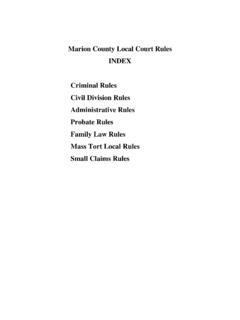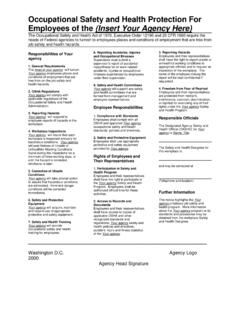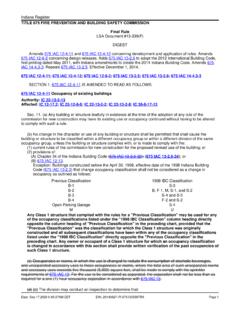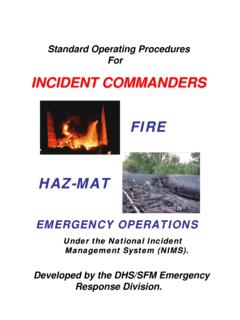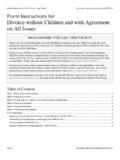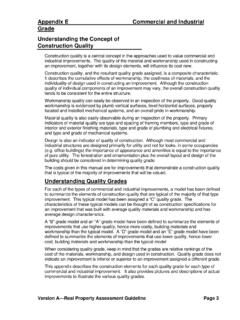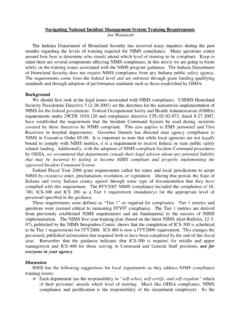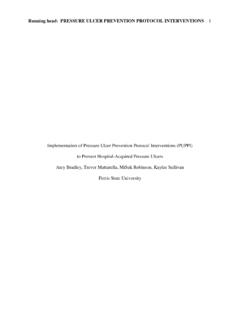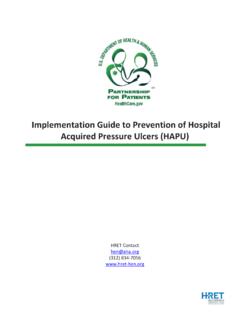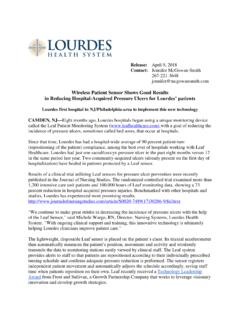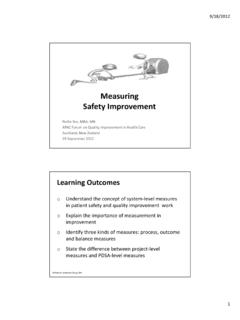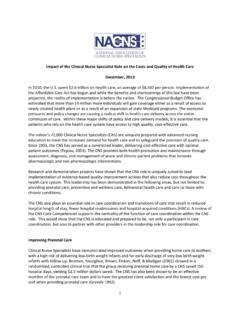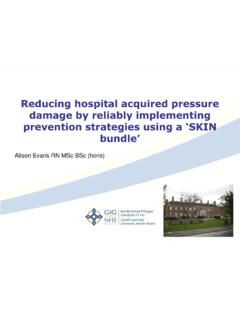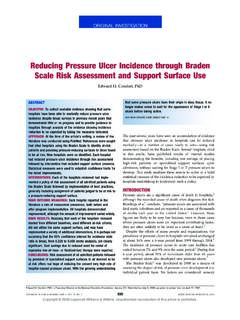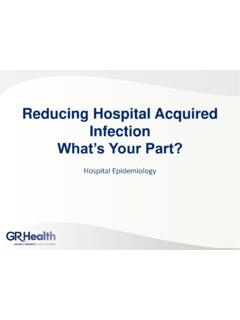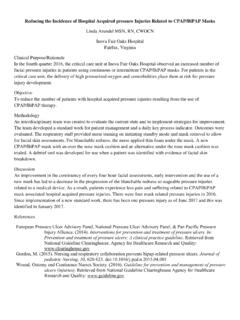Transcription of Hospital Pressure Ulcers Change Package - in.gov
1 Hospital Pressure Ulcers Change Package 2 Strategy Key Change Concepts Action Items 1. Organizational Vision and Commitment: Hospital leadership demonstrates a commitment to skin integrity Establish Pressure ulcer reduction as a strategic priority Actively educate internally and externally about goals, expected outcomes and accountabilities Establish support for a skin integrity program 1a Establish Pressure ulcer reduction as a priority and set organization level aims for reducing Pressure .
2 An Aim should be clearly stated, be measureable, achievable, and identify a timeframe. Example of an aim statement(s): o Reduce Pressure Ulcers in our Hospital by xx % within the next six months. o Maintain rate of facility acquired Pressure Ulcers at less than xx% Incorporate performance of ongoing review and trending of Pressure ulcer data including Pressure ulcer prevalence and incidence rates into ongoing monitoring of organizational performance. Examples include: Leadership to regularly receive and review data Aim statement ( ) incorporated into organizational performance measures that are reported to the Board of Directors or other appropriate governing body.
3 Communicate the Pressure ulcer reduction priority to board members and administration, medical directors, physicians/providers, families and staff. Examples of communication strategies include but are not limited to: Reports to governing board Reports to Patient Safety Council Posting of organizational performance measures Charter a multi-disciplinary team to lead skin integrity program: Possible team members: o One member with a background in wound care o Nutritionist o Therapist o staff nurse o nursing assistant o Physician(s).
4 Surgical or non-surgical or hospitalist o QI staff o Others as appropriate Establish skin integrity program priorities: Hospital Pressure Ulcers Change Package 3 Strategy Key Change Concepts Action Items o Ensure all staff realize Pressure ulcer prevention is their responsibility o Ensure that all staff understands Pressure ulcer reduction requires a combination of (1) assessing risk (looking at each Braden scale sub-category separately), (2) inspecting the skin, and then (3) implementing appropriate interventions.
5 O Ensure both new and existing staff regularly has educational review Pressure ulcer prevention policies and processes. 2. Assess organization s current practices: Interdisciplinary team analyzes current practice and identifies opportunities for improvement Identify areas for improvement in Pressure ulcer reduction Identify authoritative information currently available Analyze data to identify opportunities for improvement for improvement in Pressure ulcer prevention.
6 Data sources include but are not limited to: Quality Measures/Indicators Internal performance improvement data Prevalence and incidence data Benchmark data Ancillary Services Radiology, transport. Unit specific input Emergency Department, Intensive Care, or Surgery. Patient Satisfaction Survey b Develop a system to track and report all stages of nosocomial Pressure Ulcers Review the commonly referenced Pressure ulcer prevention research, including: Bergstrom N. Strategies for Preventing Pressure Ulcers ; In Thomas D, Allman R.
7 Clinicians in Geriatric Medicine. Philadelphia, PA: Saunders Co., 1997: 437-454. Bergstrom N, Bennett MA, Carlson CE, et. al. Treatment of Pressure Ulcers . Clinical Practice Guideline, No. 15. Rockville, MD: Department of Health and Human Services, Public Health Service, Agency for Health Care Policy and Research. Dec 1994: AHCPR Publication No. 95-0652. Bergstrom N, Braden B, Kemp M, Champagne M, Ruby E. Predicting Pressure Ulcer Risk: A Multisite Study of the Predictive Validity of the Braden Scale.
8 Nurs Res 1998; 47: 261-9. Bergstrom N, Braden, BJ, Laguzza A, Homan V. The Braden Scale for Predicting Pressure Sore Risk. Nurs Res 1987; 36: 205-10. Braden BJ, Bryant R. Innovations to Prevent and Treat Pressure Ulcers . Hospital Pressure Ulcers 4 Change Package Strategy Key Change Concepts Act ionItems Understand the organization s current approach to preventing Pressure Ulcers Geriatric NursingJul/Aug 1990; 11(4): 182-6. Allman RM, Goode PS, Patrick MM, Burst N, Bartolucci AA.
9 Pressure ulcer risk factors among hospitalized patients with activity limitation. JAMA. 1995; 273:865-870. Review evidence based-guidelines from expert professional associations and organizations AHRQ clinical guidelines NPUAP guidelines Perform literature review on selected topics that would pertain to any specialty population in your facility. Review the organizations current approach. The following processes are supported by evidence-based research and found in the above referenced guidelines.
10 These processes represent the foundation of a successful Pressure ulcer prevention program. 1. Frequency of Pressure ulcer risk assessments using a tested tool: Braden Scale Norton Scale 2. Frequency of skin inspections based on individual risk. Ideally linked to times such as: Daily cares Change in condition 3. Individualized preventive strategies based on risk assessment results. This should include but is not limited to: customized turning and re-positioning schedules use of Pressure re-distribution devices (mattresses, cushions etc.)

